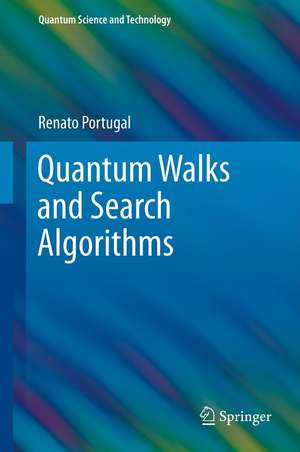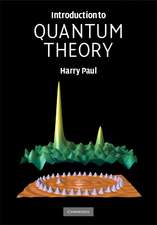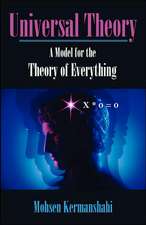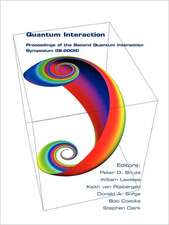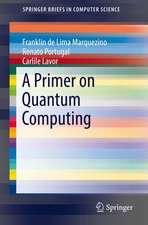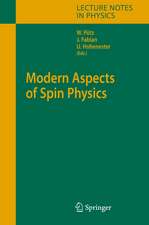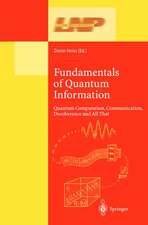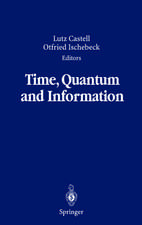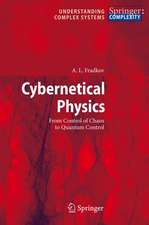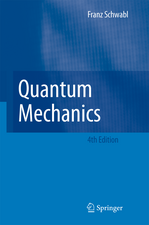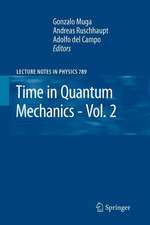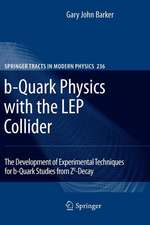Quantum Walks and Search Algorithms: Quantum Science and Technology
Autor Renato Portugalen Limba Engleză Hardback – 16 feb 2013
It is known that quantum computers have great power for searching unsorted databases. This power extends to many kinds of searches, particularly to the problem of finding a specific location in a spatial layout, which can be modeled by a graph. The goal is to find a specific node knowing that the particle uses the edges to jump from one node to the next.
This book is self-contained with main topics that include:
- Grover's algorithm, describing its geometrical interpretation and evolution by means of the spectral decomposition of the evolution operator
- Analytical solutions of quantum walks on important graphs like line, cycles, two-dimensional lattices, and hypercubes using Fourier transforms
- Quantum walks on generic graphs, describing methods to calculate the limiting distribution and mixing time
- Spatial search algorithms, with emphasis on the abstract search algorithm (the two-dimensional lattice is used as an example)
- Szedgedy's quantum-walk model and a natural definition of quantum hitting time (the complete graph is used as an example)
| Toate formatele și edițiile | Preț | Express |
|---|---|---|
| Paperback (2) | 354.21 lei 38-44 zile | |
| Springer – 7 feb 2015 | 354.21 lei 38-44 zile | |
| Springer International Publishing – 19 ian 2019 | 1109.16 lei 6-8 săpt. | |
| Hardback (2) | 425.20 lei 6-8 săpt. | |
| Springer – 16 feb 2013 | 425.20 lei 6-8 săpt. | |
| Springer International Publishing – 30 aug 2018 | 1115.28 lei 6-8 săpt. |
Din seria Quantum Science and Technology
- 15%
 Preț: 530.42 lei
Preț: 530.42 lei - 17%
 Preț: 362.72 lei
Preț: 362.72 lei - 18%
 Preț: 783.20 lei
Preț: 783.20 lei - 15%
 Preț: 643.34 lei
Preț: 643.34 lei - 18%
 Preț: 1226.24 lei
Preț: 1226.24 lei - 15%
 Preț: 644.95 lei
Preț: 644.95 lei - 18%
 Preț: 950.21 lei
Preț: 950.21 lei - 18%
 Preț: 908.52 lei
Preț: 908.52 lei - 18%
 Preț: 729.53 lei
Preț: 729.53 lei - 20%
 Preț: 928.77 lei
Preț: 928.77 lei - 18%
 Preț: 1114.34 lei
Preț: 1114.34 lei - 18%
 Preț: 1119.32 lei
Preț: 1119.32 lei -
 Preț: 451.48 lei
Preț: 451.48 lei - 18%
 Preț: 890.06 lei
Preț: 890.06 lei - 18%
 Preț: 782.57 lei
Preț: 782.57 lei - 18%
 Preț: 939.94 lei
Preț: 939.94 lei - 18%
 Preț: 892.90 lei
Preț: 892.90 lei - 18%
 Preț: 947.18 lei
Preț: 947.18 lei - 15%
 Preț: 653.33 lei
Preț: 653.33 lei - 18%
 Preț: 792.34 lei
Preț: 792.34 lei
Preț: 425.20 lei
Nou
Puncte Express: 638
Preț estimativ în valută:
81.37€ • 83.95$ • 68.87£
81.37€ • 83.95$ • 68.87£
Carte tipărită la comandă
Livrare economică 05-19 martie
Preluare comenzi: 021 569.72.76
Specificații
ISBN-13: 9781461463351
ISBN-10: 1461463351
Pagini: 236
Ilustrații: XI, 222 p. 37 illus.
Dimensiuni: 155 x 235 x 17 mm
Greutate: 0.51 kg
Ediția:2013
Editura: Springer
Colecția Springer
Seria Quantum Science and Technology
Locul publicării:New York, NY, United States
ISBN-10: 1461463351
Pagini: 236
Ilustrații: XI, 222 p. 37 illus.
Dimensiuni: 155 x 235 x 17 mm
Greutate: 0.51 kg
Ediția:2013
Editura: Springer
Colecția Springer
Seria Quantum Science and Technology
Locul publicării:New York, NY, United States
Public țintă
GraduateCuprins
Introduction.- The Postulates of Quantum Mechanics.- Introduction to Quantum Walks.- Grover's Algorithm and its Generalization.- Quantum Walks on Infinite Graphs.- Quantum Walks on Finite Graphs.- Limiting Distribution and Mixing Time.- Spatial Algorithms.- Hitting Time.- Appendix: Linear Algebra for Quantum Computation.
Recenzii
From the reviews:
“The reviewed book is a pedagogically oriented survey of the main results regarding quantum walks and quantum search algorithms. … The book is nicely written, the concepts are introduced naturally, and many meaningful connections between them are highlighted. The author proposes a series of exercises that help the reader get some working experience with the presented concepts, facilitating a better understanding. Each chapter ends with a discussion of further references, pointing the reader to major results on the topics presented in the respective chapter.” (Florin Manea, zbMATH, Vol. 1275, 2014)
“The reviewed book is a pedagogically oriented survey of the main results regarding quantum walks and quantum search algorithms. … The book is nicely written, the concepts are introduced naturally, and many meaningful connections between them are highlighted. The author proposes a series of exercises that help the reader get some working experience with the presented concepts, facilitating a better understanding. Each chapter ends with a discussion of further references, pointing the reader to major results on the topics presented in the respective chapter.” (Florin Manea, zbMATH, Vol. 1275, 2014)
Notă biografică
Dr. Renato Portugal is Researcher in the Department of Computer Science at the National Laboratory for Scientific Computing (LNCC). His past positions include Visiting Professor in the Department of Applied Mathematics and the Symbolic Computation Group at the University of Waterloo, Visiting Professor in the Department of Physics at Queen’s University of Kingston, and Researcher at the Brazilian Center for Research in Physics. He received his D.Sc. at the Centro Brasileiro de Pesquisas Fisicas, CBPF, Brazil. He has published 40 articles in Scientific Journals, 3 books, and over 30 papers in refereed proceedings. He has developed 7 software packages, including his latest: The Invar Package in 2007. He was General Chair of the Workshop-School of Quantum Information and Computation (WECIQ 2010), and Chair of the Programme Committee for the Workshop-School of Quantum Information and Computation (WECIQ 2006).
Textul de pe ultima copertă
This book addresses an interesting area of quantum computation called quantum walks, which play an important role in building quantum algorithms, in particular search algorithms. Quantum walks are the quantum analogue of classical random walks.
It is known that quantum computers have great power for searching unsorted databases. This power extends to many kinds of searches, particularly to the problem of finding a specific location in a spatial layout, which can be modeled by a graph. The goal is to find a specific node knowing that the particle uses the edges to jump from one node to the next.
This book is self-contained with main topics that include:
It is known that quantum computers have great power for searching unsorted databases. This power extends to many kinds of searches, particularly to the problem of finding a specific location in a spatial layout, which can be modeled by a graph. The goal is to find a specific node knowing that the particle uses the edges to jump from one node to the next.
This book is self-contained with main topics that include:
- Grover's algorithm, describing its geometrical interpretation and evolution by means of the spectral decomposition of the evolution operater
- Analytical solutions of quantum walks on important graphs like line, cycles, two-dimensional lattices, and hypercubes using Fourier transforms
- Quantum walks on generic graphs, describing methods to calculate the limiting distribution and mixing time
- Spatial search algorithms, with emphasis on the abstract search algorithm (the two-dimensional lattice is used as an example)
- Szedgedy's quantum-walk model and a natural definition of quantum hitting time (the complete graph is used as an example)
Caracteristici
Serves as the first textbook on Quantum Walks, which is an active area of research with growing interest Features exercises and guidelines in each chapter to use or develop computer programs for simulation of quantum walks Contains topics that students will learn faster and with more ease than would be possible from the primary research literature Includes supplementary material: sn.pub/extras
Descriere
Descriere de la o altă ediție sau format:
This book explores quantum walks, which are important in building quantum algorithms. Coverage includes Grover's algorithm; Analytical solutions of quantum walks using Fourier transforms; Quantum walks on generic graphs; Spatial search algorithms and more.
This book explores quantum walks, which are important in building quantum algorithms. Coverage includes Grover's algorithm; Analytical solutions of quantum walks using Fourier transforms; Quantum walks on generic graphs; Spatial search algorithms and more.
